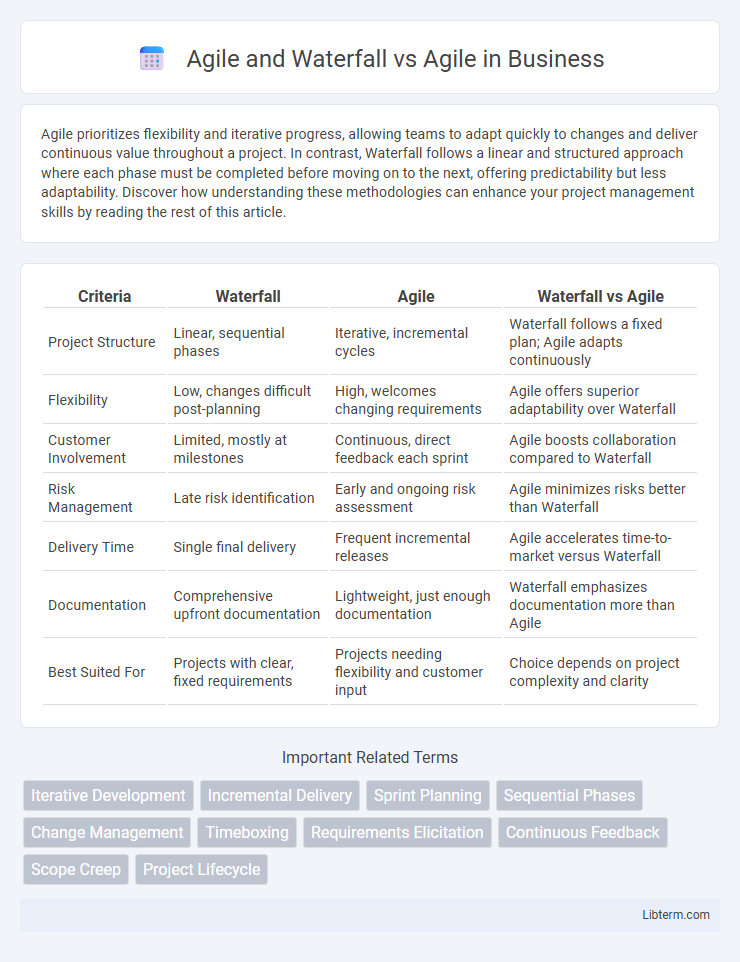Agile prioritizes flexibility and iterative progress, allowing teams to adapt quickly to changes and deliver continuous value throughout a project. In contrast, Waterfall follows a linear and structured approach where each phase must be completed before moving on to the next, offering predictability but less adaptability. Discover how understanding these methodologies can enhance your project management skills by reading the rest of this article.
Table of Comparison
| Criteria | Waterfall | Agile | Waterfall vs Agile |
|---|---|---|---|
| Project Structure | Linear, sequential phases | Iterative, incremental cycles | Waterfall follows a fixed plan; Agile adapts continuously |
| Flexibility | Low, changes difficult post-planning | High, welcomes changing requirements | Agile offers superior adaptability over Waterfall |
| Customer Involvement | Limited, mostly at milestones | Continuous, direct feedback each sprint | Agile boosts collaboration compared to Waterfall |
| Risk Management | Late risk identification | Early and ongoing risk assessment | Agile minimizes risks better than Waterfall |
| Delivery Time | Single final delivery | Frequent incremental releases | Agile accelerates time-to-market versus Waterfall |
| Documentation | Comprehensive upfront documentation | Lightweight, just enough documentation | Waterfall emphasizes documentation more than Agile |
| Best Suited For | Projects with clear, fixed requirements | Projects needing flexibility and customer input | Choice depends on project complexity and clarity |
Understanding Agile and Waterfall Methodologies
Agile methodology emphasizes iterative development, collaboration, and flexibility, allowing teams to respond quickly to changing requirements and deliver incremental value throughout the project lifecycle. Waterfall methodology follows a linear, sequential approach where each phase, such as requirements, design, implementation, testing, and deployment, is completed before moving to the next, providing a clear structure but limited adaptability. Understanding these methodologies helps organizations choose between Agile's adaptability and Waterfall's predictability based on project complexity, stakeholder involvement, and risk tolerance.
Core Principles of Agile vs Waterfall
Agile emphasizes iterative development, customer collaboration, and responsiveness to change, promoting flexibility and continuous improvement throughout the project lifecycle. Waterfall follows a linear, sequential approach with distinct phases such as requirements, design, implementation, testing, and maintenance, prioritizing thorough documentation and upfront planning. Agile's core principles foster adaptability and early delivery of functional software, whereas Waterfall focuses on structured progression and fixed project scope.
Key Differences Between Agile and Waterfall
Agile emphasizes iterative development, flexibility, and continuous feedback, enabling teams to adapt quickly to changing requirements, whereas Waterfall follows a linear, sequential approach with distinct phases and fixed scope. Agile promotes collaboration and frequent releases, ensuring early detection of issues, while Waterfall relies on thorough upfront planning and documentation before moving to the next phase. The key differences lie in flexibility, risk management, and customer involvement, with Agile encouraging ongoing stakeholder input and Waterfall focusing on upfront commitment and predictability.
Advantages of Agile Over Waterfall
Agile enhances project flexibility by allowing continuous iteration, frequent feedback, and adaptive planning, which leads to faster delivery and higher customer satisfaction. Unlike Waterfall's rigid, linear phases, Agile supports collaborative teams and iterative progress, reducing risks associated with changing requirements. Agile's emphasis on real-time communication and incremental releases improves product quality and responsiveness to market demands.
Situations Where Waterfall Outperforms Agile
Waterfall outperforms Agile in projects with well-defined requirements and fixed scopes, such as construction or manufacturing, where sequential phases ensure thorough documentation and compliance. In industries with strict regulatory standards like aerospace or healthcare, Waterfall's structured approach facilitates audits and maintains traceability. Large-scale projects with stable, unchanging objectives benefit from Waterfall's predictability and detailed planning, minimizing scope creep and enhancing risk management.
Project Suitability: Agile vs Waterfall
Waterfall methodology is ideal for projects with well-defined requirements and a fixed scope, such as construction or manufacturing, where sequential progress ensures clarity and control. Agile suits dynamic projects needing flexibility and iterative progress, like software development or marketing campaigns, allowing for continuous feedback and adaptation. Choosing between Agile and Waterfall depends on project complexity, stakeholder involvement, and the need for ongoing changes.
Hybrid Approaches: Merging Agile and Waterfall
Hybrid approaches combine Agile and Waterfall methodologies to leverage the structured planning of Waterfall with the flexibility and iterative feedback of Agile. This integration allows teams to manage complex projects by using Waterfall's predictive phases for initial requirements and budgeting, while applying Agile's adaptive cycles for development and testing. Adopting a hybrid model enhances project control and responsiveness, improving delivery times and stakeholder collaboration.
Challenges in Transitioning from Waterfall to Agile
Transitioning from Waterfall to Agile presents challenges including resistance to change, as teams accustomed to linear processes struggle with Agile's iterative nature. Communication gaps and lack of Agile expertise hinder effective collaboration and timely delivery of sprints. Addressing these issues requires comprehensive training, cultural shifts, and incremental adoption of Agile practices to ensure successful transformation.
Impact on Project Management and Teams
Agile methodologies emphasize iterative development, continuous feedback, and flexibility, significantly enhancing team collaboration and responsiveness to change, which improves project outcomes and stakeholder satisfaction. In contrast, Waterfall's linear and sequential approach can lead to rigid project timelines and limited scope for mid-course adjustments, often causing challenges in risk management and delayed issue resolution. Agile's impact on project management promotes adaptive planning and empowered teams, whereas Waterfall relies on upfront planning and hierarchical decision-making, affecting team dynamics and project flexibility.
Choosing the Right Methodology for Your Organization
Choosing the right project management methodology depends on your organization's goals, team structure, and project requirements. Agile offers flexibility, iterative progress, and adaptability, making it ideal for dynamic projects with evolving scope, while Waterfall provides a structured, linear approach suited for projects with well-defined deliverables and timelines. Evaluating factors such as stakeholder involvement, risk tolerance, and delivery deadlines ensures selecting the methodology that maximizes efficiency and project success.
Agile and Waterfall Infographic

 libterm.com
libterm.com